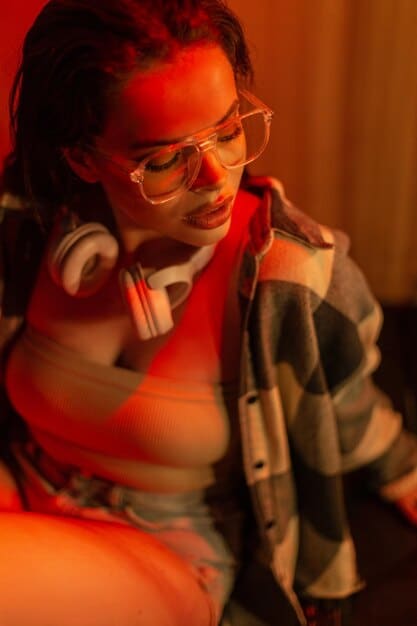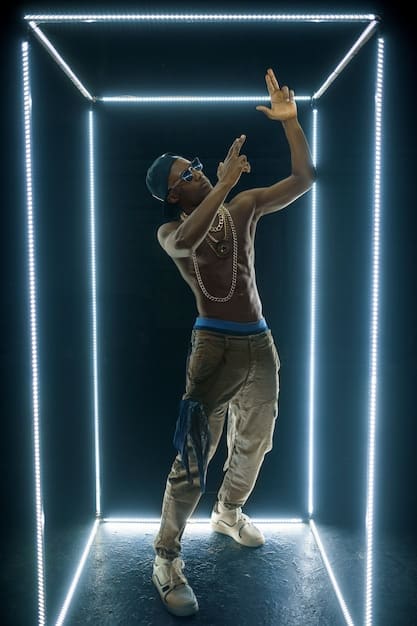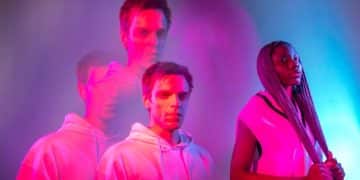Hip Hop’s Digital Thriving: Independent Artists Revolutionize Business

Independent artists are revolutionizing the hip hop industry by leveraging digital platforms and innovative business models, moving beyond traditional label reliance to build direct fan connections and cultivate sustainable careers in the modern music landscape.
The journey of music has always been intertwined with its commercial viability, and nowhere is this more evident than in the dynamic world of hip hop. Once dominated by major labels, a profound transformation is reshaping the industry. We will explore The Business of Hip Hop: How Independent Artists Are Thriving in the Digital Age, a compelling narrative of innovation, entrepreneurship, and artistic freedom that stands in stark contrast to yesterday’s music paradigms.
The independent revolution: breaking free from traditional labels
For decades, the path to success in hip hop seemed to funnel exclusively through major record labels. These monolithic entities controlled distribution, marketing, and the very narrative of an artist’s career. However, the rise of digital technologies has ushered in an era where this traditional gatekeeper model is being dismantled, piece by piece.
Independent artists are no longer waiting for a major label deal to validate their talent or distribute their music. Armed with accessible creative tools and a global digital reach, they are taking the reins, building their enterprises from the ground up, and dictating their own terms of engagement with the audience. This shift isn’t just about avoiding contracts; it’s about reclaiming ownership of their art and their businesses.
Democratizing music production and distribution
The barriers to entry in music creation have significantly lowered. Software like Pro Tools, Logic Pro, and even GarageBand allow artists to produce, mix, and master tracks with professional quality from their home studios. This accessibility feeds into a larger ecosystem of independent distribution platforms.
- Digital aggregators: Services like DistroKid, TuneCore, and CD Baby enable artists to upload their music directly to major streaming services and digital storefronts worldwide.
- Direct-to-fan platforms: Sites such as Bandcamp offer artists powerful tools to sell music, merchandise, and even set up subscription models directly to their most dedicated fans, retaining a significantly larger share of revenue.
- Social media as a launchpad: Platforms like Instagram, TikTok, and YouTube serve as crucial discovery engines, allowing artists to organically reach new audiences without the need for extensive marketing budgets.
The ability to control the entire production and distribution process from conception to consumption gives independent artists unprecedented autonomy. They can release music on their own schedule, experiment with different sounds, and respond rapidly to audience feedback, fostering a more direct and authentic connection.
This autonomy extends to financial independence. By bypassing traditional intermediaries, independents retain a much larger percentage of their earnings. While major labels might offer larger advances, they often recoup those against an artist’s entire revenue stream, leaving little for the artist in the long run. Independent artists, conversely, build wealth directly, reinvesting in their careers and communities.
In essence, the independent revolution in hip hop is a testament to the power of self-determination. It’s about recognizing that creativity alone isn’t enough; strategic business acumen and a willingness to embrace new technologies are vital ingredients for success in the 21st century music landscape.
Leveraging digital platforms: audience building and engagement
The digital age has fundamentally altered how artists connect with their audience. No longer are fans solely reliant on radio airplay or music video rotations for discovery. Today, a myriad of platforms empowers independent hip hop artists to build and nurture their fan bases directly, fostering communities that are both loyal and highly engaged.
This direct engagement is a cornerstone of the modern independent artist’s business model. It shifts the dynamic from a one-way broadcast to a two-way conversation, where artists can respond to feedback, share their creative process, and truly personalize the fan experience. Understanding and strategically utilizing these platforms is crucial.
The power of streaming and social media
Streaming services are the new radio. Platforms like Spotify, Apple Music, and Amazon Music are primary discovery hubs, and accumulating streams is essential. However, the business model here is nuanced; while per-stream payouts are low, the sheer volume and global reach can be transformative. Independent artists must focus on playlist placements, algorithmic recommendations, and encouraging listener saves to maximize their exposure.
Social media, however, is where the magic of true connection often happens. Each platform offers unique advantages:
- TikTok: An undeniable powerhouse for virality. Short-form, engaging content can turn an unknown artist into an overnight sensation. The focus here is on soundbites, dance challenges, and creative storytelling that encourages user-generated content.
- Instagram: Ideal for visual storytelling, behind-the-scenes glimpses, and engaging with fans through Stories, Reels, and Live sessions. Artists can use it to announce releases, share daily life, and build a cohesive brand identity.
- YouTube: The ultimate platform for music videos, Vlogs, and long-form content. It allows artists to showcase their visual artistry and provide deeper insights into their creative process, often serving as a primary revenue stream through ad revenue.
- Discord/Patreon: For deeper fan engagement and monetization. These platforms allow artists to build exclusive communities, offer premium content, and receive direct financial support from their most dedicated followers, fostering a sense of belonging and direct patronage.
The key is not to be everywhere, but to be strategic about where an artist invests their time and energy. Understanding where their target audience congregates and tailoring content to each platform’s unique format is vital. Authenticity resonates deeply; fans connect with genuine personalities and stories, not just polished performances.
Moreover, robust engagement metrics on these platforms signal success beyond mere follower counts. Likes, shares, comments, and saves are indicators of genuine interest and affinity. For independent artists, these are not just vanity metrics; they are direct feedback loops that inform future content creation, marketing strategies, and ultimately, monetization efforts.
In essence, digital platforms are the laboratories where independent hip hop artists experiment, connect, and grow. They are less about traditional advertising and more about building relationships, transforming casual listeners into passionate patrons, and creating a sustainable ecosystem around their art.

Innovative monetization strategies: beyond streaming royalties
While streaming platforms offer crucial exposure, their per-stream payouts are notoriously low. This reality forces independent hip hop artists to be highly creative and resourceful in their approaches to monetization. The most successful independents understand that their business extends far beyond just song streams; it encompasses a diverse portfolio of revenue streams.
Diversification is the watchword for financial stability in the digital age. By exploring multiple avenues, artists reduce their reliance on any single income source, creating a more resilient and profitable career. This multi-faceted approach allows them to sustain their art and invest in its future growth.
Merchandise, fan subscriptions, and direct sales
Selling merchandise has long been a staple for musicians, but independent artists are supercharging this revenue stream with innovative approaches. Beyond standard t-shirts and hoodies, they offer unique, limited-edition items that resonate with their brand and fanbase. This includes:
- Exclusive apparel: Collaborating with designers for unique drops or creating custom pieces that reflect their artistic vision.
- Physical media: Releasing limited runs of vinyl, CDs, or cassettes that cater to collectors and offer a tangible memento in a digital world.
- Digital products: Selling beat packs, vocal samples, production tutorials, or exclusive digital content.
Fan-centric platforms like Patreon, YouTube Memberships, and even direct website subscriptions are transforming the fan-artist relationship into a direct patronage model. Loyal fans pay a recurring fee for exclusive content, early access, behind-the-scenes peeks, and direct interaction. This stable, predictable income is invaluable for independent artists, allowing them to focus more on creation and less on chasing trends.
Direct sales, particularly through platforms like Bandcamp, allow artists to set their own prices and retain a significantly higher percentage of sales. This model empowers fans to directly support artists, often paying more than the minimum price out of goodwill and appreciation. It fosters a powerful sense of community and shared investment.
Beyond these, other burgeoning revenue streams include synchronisation licensing (music for films, TV, games, commercials), brand partnerships, and even venturing into the nascent world of NFTs (Non-Fungible Tokens) for unique digital collectibles or fan experiences. NFTs, while still evolving, represent a new frontier for independent artists to unlock direct value from their digital creations and engage high-value collectors.
The entrepreneurial spirit of hip hop artists is perfectly suited for this diversified approach. They are not just musicians; they are CEOs, marketers, product developers, and community managers. This holistic view of their craft as a business is what truly allows independent hip hop artists to not just survive, but to thrive financially in a landscape that demands innovation and self-reliance.
The role of community and collaboration
In the fiercely competitive music industry, often portrayed as a struggle for individual stardom, independent hip hop artists are increasingly demonstrating the profound power of community and collaboration. This isn’t just about sharing a track; it’s about building networks, sharing resources, and collectively elevating the scene.
The digital age, paradoxically, has made it easier than ever for artists to connect and collaborate across geographical boundaries. Online forums, social media groups, and remote recording technologies have replaced the need for physical proximity, opening up a world of possibilities for shared creativity and mutual support.
Building a supportive ecosystem
Independent artists frequently form collectives, not necessarily as formal labels, but as groups for creative support, shared marketing efforts, and mutual development. These collectives embody a ‘rising tide lifts all boats’ mentality, where individual success often benefits the group, and vice versa. This can involve:
- Shared studios and equipment: Pooling resources to access better recording gear or studio spaces than an individual might afford.
- Cross-promotion: Artists promoting each other’s music and content to their respective fan bases, exposing their art to new audiences.
- Skill sharing: Producers helping vocalists, graphic designers creating cover art, videographers shooting music videos – all within a supportive network.
Collaboration extends beyond just other artists. Independent hip hop thrives on partnerships with independent producers, videographers, graphic designers, publicists, and even digital marketing specialists. These individuals might also be independent contractors, fostering a micro-economy built on shared passion and mutual benefit.
This collaborative spirit often permeates local scenes, where independent artists organize their own showcases, open mic nights, and community events. These events serve as vital proving grounds for new material, networking opportunities, and a way to build a grassroots following. The direct interaction with local fans and other artists is irreplaceable.
Furthermore, the hip hop culture itself is founded on collaboration, from open mic cyphers to guest features on albums. Independent artists lean into this tradition, seeing features not just as a way to boost their own profile, but as a genuine artistic exchange. This creates a vibrant, interconnected web of creativity that strengthens the entire independent ecosystem.
Ultimately, the strength of independent hip hop lies not just in individual talent, but in the collective power of its community. By fostering genuine connections, sharing knowledge, and actively collaborating, artists create a resilient environment where creativity can flourish and business can thrive, far from the traditional confines of established industry structures.
Marketing and branding in the digital landscape
In a saturated digital environment where countless artists vie for attention, effective marketing and strong personal branding are absolutely critical for independent hip hop artists. It’s no longer enough to just make great music; artists must also be adept at telling their story, defining their unique identity, and strategically reaching their audience.
The digital landscape offers unprecedented tools for self-promotion, but it also demands a sophisticated understanding of how to cut through the noise. This requires a coherent strategy that encompasses visual identity, narrative, and consistent messaging across all platforms.
Crafting a compelling narrative and visual identity
A strong brand for an independent hip hop artist goes beyond just a logo or an album cover. It’s an overarching narrative that encompasses their sound, their message, their personal story, and their aesthetic. This consistency builds recognition and trust with the audience. Key elements include:
- Visual branding: This includes everything from album art, social media aesthetics, music video cinematography, to personal style. A consistent and unique visual identity makes an artist memorable.
- Narrative storytelling: Artists should articulate their “why.” What inspires them? What message do they want to convey? Sharing personal journeys, struggles, and triumphs creates an emotional connection with fans.
- Niche targeting: Instead of trying to appeal to everyone, successful independent artists often hone in on a specific subgenre, style, or message that resonates with a dedicated audience. This allows for more targeted marketing efforts.
Digital marketing for independent artists often relies heavily on organic strategies. Content marketing, through short-form videos, engaging social media posts, and behind-the-scenes content, helps build anticipation and keep the audience engaged between releases. Utilizing trending sounds on platforms like TikTok or participating in viral challenges can amplify reach significantly.
Paid advertising, while often seen as something only for major labels, is becoming more accessible for independents. Targeted ads on platforms like Instagram, Facebook, and YouTube can reach specific demographics and interests, efficiently promoting new music or merchandise to potential fans who are most likely to convert into listeners or buyers.
Crucially, independent artists must be their own PR agents. This means understanding how to craft compelling press releases, engaging with music blogs and online publications, and networking with influential voices within the hip hop community. Building genuine relationships with tastemakers can lead to invaluable exposure.
In essence, successful independent marketing and branding are about authenticity and consistency. It’s about presenting a cohesive artistic persona across all digital touchpoints, effectively communicating what makes an artist unique, and strategically engaging with the audience to foster a loyal and growing community of fans.
Legal and business essentials for independent artists
While artistic expression is at the heart of hip hop, the sustainable growth of an independent artist’s career hinges on a solid understanding of fundamental legal and business principles. Neglecting these aspects can lead to significant financial and creative setbacks, regardless of how popular an artist becomes.
Operating as an independent artist means taking on the responsibilities of a small business owner. This includes understanding intellectual property rights, navigating contracts (even with collaborators), managing finances, and ensuring compliance with relevant regulations. It’s the less glamorous but equally vital side of the music business.
Copyright, royalties, and registration
Copyright protection is paramount for any artist. It grants exclusive rights to reproduce, distribute, perform, and display their original work. Without proper legal understanding and registration, an artist’s creations can be exploited without their consent or compensation.
- Songwriting copyright: Protects the lyrics and musical composition. Artists should register their songs with the U.S. Copyright Office.
- Sound recording copyright: Protects the specific recording of a song. Both the composition and the master recording are separate copyrights.
- Performance Rights Organizations (PROs): Artists need to register with PROs like ASCAP, BMI, or SESAC to collect public performance royalties whenever their music is played on radio, TV, in venues, or via streaming services.
- Mechanical Royalties: Collected for the reproduction of musical compositions (e.g., when a song is streamed, downloaded, or pressed onto physical media). Administered by entities like The MLC (Mechanical Licensing Collective) in the U.S.
Beyond copyright, independent artists must grasp the basics of business formation. Should they operate as a sole proprietorship, an LLC, or a corporation? Each structure has different implications for liability, taxation, and administrative burden. Consulting with a legal or financial expert is often advisable to make the most informed decision as their career grows.
Contractual agreements, even informal ones with co-writers, producers, or collaborators, are crucial. A clear agreement outlines ownership, royalties splits, and responsibilities, preventing disputes down the line. Simple written agreements are always better than verbal understandings.
Financial management is another non-negotiable. Independent artists must track income and expenses meticulously for tax purposes. Separating personal and business finances, keeping robust records, and potentially hiring an accountant are essential steps towards financial health and long-term sustainability.
The digital age, while simplifying distribution, also introduces complexities related to international royalties and digital rights management. Staying informed about evolving laws and best practices in the digital music landscape is an ongoing responsibility for any serious independent artist aiming for sustained success.
In summary, the transition from artist to artist-entrepreneur requires diligence and a willingness to learn about the legal and financial frameworks that underpin their creative endeavors. By addressing these essentials, independent hip hop artists can protect their assets, maximize their earnings, and build a truly resilient business around their passion.
Future trends and sustained success for independent hip hop
The landscape of the music industry is in constant flux, driven by technological advancements and evolving consumer behaviors. For independent hip hop artists to not just thrive but sustain their success, they must remain agile, adaptable, and forward-thinking, keeping an eye on emerging trends and embracing future innovations.
The narrative of the hip hop business will continue to be written by those who understand that disruption is the new norm. Artists who proactively integrate new tools, platforms, and strategies will be best positioned for long-term growth and relevance.
Web3, AI, and immersive experiences
The nascent but rapidly developing sphere of Web3, encompassing blockchain technology, NFTs, and decentralized autonomous organizations (DAOs), holds significant promise for independent artists. NFTs, for instance, could evolve beyond digital collectibles to become foundational for direct artist-fan engagement, offering fractional ownership of songs, exclusive access to content, or even new models for royalty distribution.
- NFTs for unique experiences: Beyond just selling art, NFTs can be tied to exclusive concert access, behind-the-scenes content, or even voting rights on creative decisions.
- DAOs for collective ownership: Artist-led DAOs could allow fans to collectively fund projects, own a share of an artist’s future royalties, or participate in collective creative decisions.
- Direct artist-fan ecosystems: Web3 could facilitate a more direct value exchange, cutting out many intermediaries and empowering artists with greater control over their intellectual property and revenue.
Artificial intelligence (AI) is already impacting music creation, from generating beats and melodies to aiding in mixing and mastering. For independent artists, AI tools can streamline production processes, personalize marketing efforts, and even assist with data analysis to better understand their audience. The ethical considerations and creative boundaries of AI in music will be a key discussion point in the coming years.
Immersive experiences, such as virtual reality (VR) and augmented reality (AR) concerts, are also on the horizon. These technologies offer new ways for artists to connect with global audiences and deliver unique performances that transcend physical limitations. Independent artists who experiment with these formats early could gain a significant advantage in creating memorable and engaging fan experiences.
Beyond technology, the importance of genuine connection and authentic storytelling will remain paramount. As the digital world becomes more complex, human connection often stands out. Independent artists who prioritize building real relationships with their fanbase, fostering community, and staying true to their artistic vision are likely to build more resilient and enduring careers.
Ultimately, sustained success for independent hip hop artists in the digital age will come from a blend of artistic integrity, entrepreneurial spirit, technological adoption, and a deep understanding of their audience. The future is bright for those who are willing to innovate and redefine what it means to be a successful musician.

| Key Aspect | Brief Description |
|---|---|
| 🚀 Independent Control | Artists now control production, distribution, and branding, bypassing traditional labels for autonomy. |
| 📈 Digital Platform Leverage | Streaming and social media are crucial for audience building and direct engagement with fans. |
| 💰 Diverse Monetization | Revenue comes from merch, fan subscriptions, direct sales, and potentially new models like NFTs, not just streams. |
| 🤝 Community & Collaboration | Building networks, sharing resources, and mutual support are vital for collective growth in the independent scene. |
FAQs about the Business of Hip Hop
▼
Independent artists diversify their income streams significantly. This includes selling merchandise directly to fans, offering exclusive content through fan subscription services like Patreon, and direct sales of digital music on platforms such as Bandcamp. They also explore revenue from sync licensing for film/TV, brand partnerships, and emerging avenues like NFTs, which offer unique digital assets and fan experiences.
▼
Key digital platforms include digital aggregators (DistroKid, TuneCore) for widely distributing music to streaming services (Spotify, Apple Music). Social media platforms like TikTok, Instagram, and YouTube are vital for audience discovery and engagement. Additionally, direct-to-fan platforms like Bandcamp, and community hubs like Discord or Patreon, facilitate deeper connections and direct financial support from loyal fans.
▼
Branding is exceptionally important; it defines an artist’s unique identity in a crowded market. A strong brand encompasses consistent visual aesthetics, a compelling personal narrative, and a clear artistic message. Effective branding helps artists connect deeply with their target audience, makes them memorable, and creates a cohesive presence across all digital platforms, fostering loyalty and recognition.
▼
Independent artists must understand and protect their intellectual property through copyright for both songwriting and sound recordings. Registering with Performance Rights Organizations (PROs) like ASCAP or BMI is crucial for collecting public performance royalties. Additionally, they should be aware of mechanical royalties, basic business formation (e.g., LLCs), and the importance of clear contractual agreements with collaborators to avoid disputes.
▼
AI is increasingly influencing independent hip hop by assisting with music production, such as generating beats and melodies, and aiding in mixing/mastering. It also helps artists streamline marketing efforts through data analysis and personalized content delivery. While raising ethical questions, AI tools offer efficiencies and new creative avenues, potentially empowering independent artists further in composition and audience engagement.
Conclusion
The journey of independent hip hop artists in the digital age is a powerful testament to resilience, innovation, and self-determination. By embracing digital platforms, diversifying revenue streams, fostering strong communities, and mastering essential business acumen, these artists are not just surviving, but actively redefining success within the music industry. Their path offers a compelling blueprint for creative entrepreneurship, proving that artistic vision, combined with strategic business practices, can indeed lead to thriving careers in an ever-evolving landscape.





